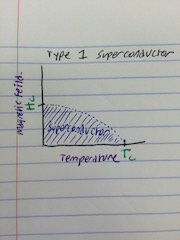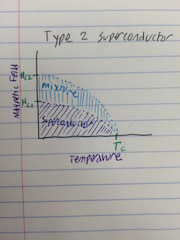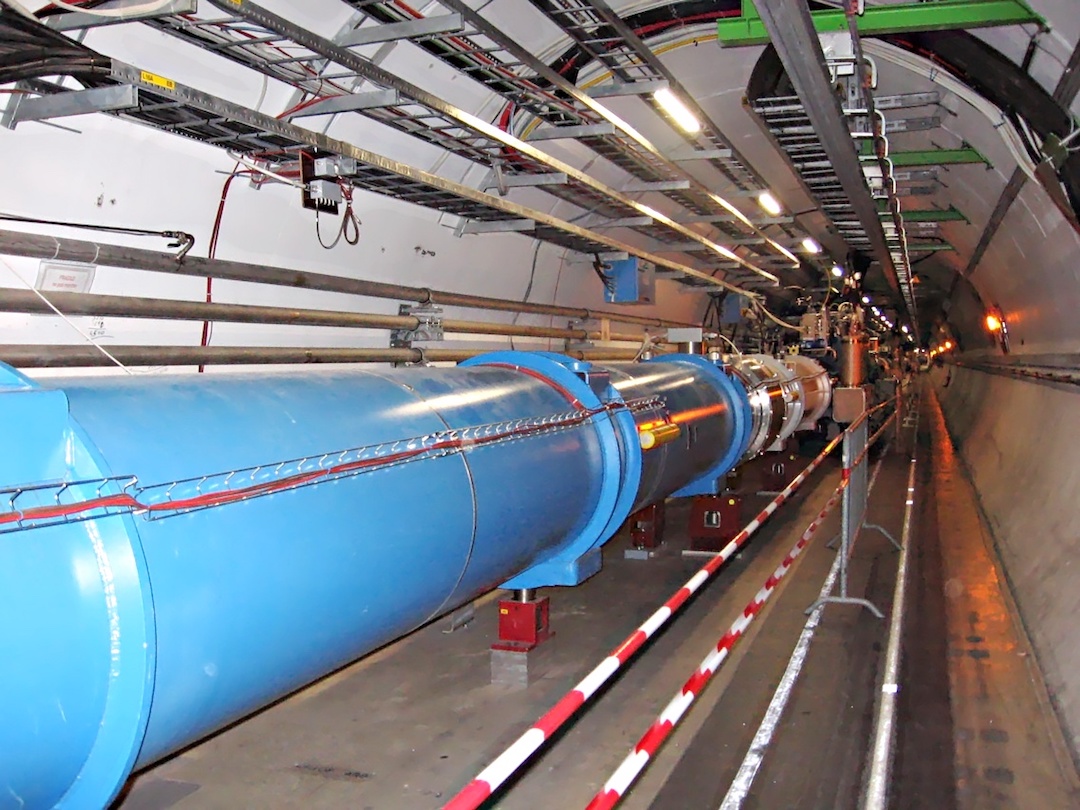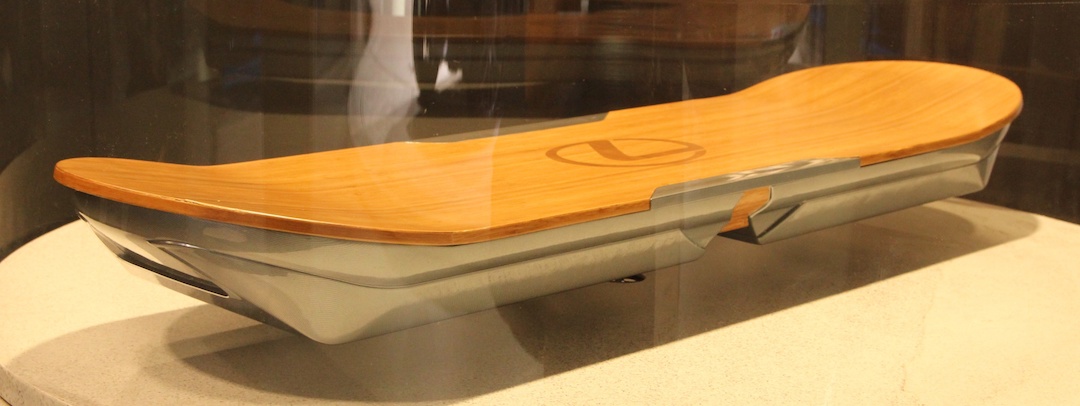Superconductors
Claimed by Luis Alberto Icaza Superconductors are materials that can conduct electricity (or current) perfectly, meaning that no energy is lost to electric resistance and there is no magnetic flux fields expelled when they carry a current. In order to understand the significance of this property of superconductors and see some examples, it's important to understand what electrical resistance is and why it can become a problem when moving energy around. Superconductors can also prevent the prescience of all magnetic fields on the inside of the material itself, known by the name of the Meisner effect .
Introduction to Resistance
Electric resistance is a property of all metals and conductors except superconductors. It is the reason why electronics deteriorate with use, in part due to the heat generated when current is passed through a conductor with electric resistance. This is happens because the resistance of the conductor which the electric current is trying to cross, resists the flow of current and in this resistance it generates heat from the “friction” of the current against the resistance.
In essence, electric resistance refers to how difficult it is for electrons to pass through a conductor. Where analogically, resistance behaves like the friction force found through classic Newtonian physics in mechanical systems, because it removes energy from what would without its presence be essentially a perfectly closed system. It's easy to think about electric resistance in the same way as you would water flowing through a pipe, thinking of the water as the current and obstacles in the pipe as the resistance of a conductor, where the amount, and size of the obstacles relates to how much electric resistance there is; with a higher obstruction of the flow of water in the pipe, relating in this analogy to a higher electric resistance.
In a conductor and current situation, electrons flow between metal ions towards their endpoints. How well they stick to these electrons is a measure of their resistance relating back to the friction analogy. Depending on the material that the conductor is made off, the metal ions will hold onto the electrons more or less, and cause them to flow through at different rates. The more tightly held the electrons are on their way to the end of the wire, the more energy they lose, in part as heat, as a result. But, in a superconductor, this is eliminated and the electrons are able to go from their start points to their endpoints without losing energy. Unfortunately, most superconductors require temperatures that get very close to absolute zero, which is extremely difficult to maintain even in an environment as controlled as a lab.
About Superconductors
When you lower the temperature of a metal, its resistance will decrease. You could demonstrate this by taking a basic circuit and freezing it- because of ohm's law, the bulb would start to glow brighter since there is a lot more current flowing through until it heated up and the effect was nullified. (V=IR, lowering R will raise I which will raise brightness). For most materials, taking them to absolute zero (or really close) will cause the resistance to decrease to almost zero, or at least improve from where it was, but not quite zero. However, some materials, superconductors, lose all resistance to current. The difference between "almost zero" and "actually zero" is enough to give rise to some cool properties of superconductors. What is happening on the molecular level is that the atoms are not vibrating quickly enough to be attracted to electrons any more, and attractions are minimized to the point where the electrons can flow through with no resistance.
It's like running through a tunnel where everyone wants to high five you. You're the electron, and the people trying to high five you are atoms in the wire. If it's too cold, nobody will want to high five you and you will run faster.
Superconductors will only be superconductors if within a certain range beneath their critical temperature and critical magnetic field. If it is warmer than these values, or the magnetic field is stronger, they might be really good conductors, but not super conductors.
Critical Temperature- often labeled as Tc, or critical temperature. This is the temperature at which the superconductor needs to be beneath in order for it to exhibit these behaviors. Some superconductors are more useful than others because they have higher critical temperatures. To see a table of these, click here. Obviously, some have more practical applications than others because of these temperatures.
Critical Magnetic Field- often labeled as Hc. A superconductor also won't exhibit any of its properties if a magnetic field is greater than a certain value, called the critical magnetic field, even at absolute zero. Superconductors that have higher critical temperatures usually have higher critical magnetic fields, but the correlation isn't exact.
Meisner effect- unique to superconductors, this is the ability to cancel out all external magnetic fields on the inside of the superconductor below the critical magnetic field. Below the critical magnetic field, the superconductor can create mini currents on its surface to eliminate these in the same way that a block of metal can automatically generate an electric field to block out an external electric field, making its net electric field zero. Basically, you could never be asked to do a hall effect problem with a superconductor!
There are two types of superconductors, cleverly named Type 1 and Type 2. Their classification is based on how they break down once their critical magnetic field is reached. Under the critical magnetic field and critical temperature, they all behave similarly.
Type 1- The first type of superconductor is one that has been experimented with the longest. When they are raised above their critical magnetic field, they simply stop being superconductors. Most commonly, these are pure metals like Aluminum and Mercury.
Type 2- when at the critical magnetic field, type 2 superconductors will slowly lose their properties, rather than just completely becoming normal conductors like Type 1. When they break down, they form mini currents and somewhat exhibit the Meisner effect, having a mix of properties between conductors and superconductors. They exhibit 2 critical Magnetic fields, Hc1 where they are no longer complete superconductors, and Hc2 when they are no longer partial superconductors. These superconductors aren't fully understood and need to be further researched.
History of Superconductors
1911- Superconductors were first discovered by Heike Kamerlingh Onnes, a Dutch Physicist. He experimented with mercury, a type 1 superconductor, below 4 degrees celcius.
1935- Type 2 superconductors were first discovered by Leb Shubnikov.
1950s- Lev Lendau and Vitaly Ginzburg were the first to theorize about why type 2 superconductors existed.
1972- The basic theory of superconductivity was published by John Bardeen, Leon Cooper, and John Schrieffer. They went on to win a nobel prize.
1986- Karl Muller and Johannes Bednorz realized that superconductors didn't have to be at absolute zero, and found a way to create one that operated at 40 degrees kelvin.
2015- We acheived the greatest record of superconducter temperature at 203 degrees kelvin, but under high pressure. We've been using pressure to cheat the temperature requirements for a while. This was the work of A. P. Drozdov,M. I. Eremets,I. A. Troyan, V. Ksenofontov, and S. I. Shylin.
Applications of Superconductors
Large Hadron Supercollider- The Large Hadron Supercollider runs between France and Switzerland, and is used to experiment with fundamental particles and other complicated stuff. It uses superconductors to accelerate particles to super high speeds so that they can be observed. For more information about the LHC, click here.
Photo curtesy of https://commons.wikimedia.org/wiki/File:CERN_LHC_Tunnel1.jpg
Futuristic Technology like Hover boards- through a phenomena called Quantum Levitation, superconductors can be used to create things that levitate- the superconductor will float easily above a magnet. This could be potentially used for all sorts of levitation devices like cars, hoverboards, or stuff we can't even imagine yet. To read more about Quantum Levitation, click here.
Photo curtesy of https://commons.wikimedia.org/wiki/File:Lexus_Hoverboard_mockup_at_IAA_Frankfurt_2015_IMG_9297.jpg
Cool cell phones- current never disappears in a superconducting loop of metal, so technology with superconducting metal would never run out of power, but continue to be charged forever. This could cut down on electricity usage worldwide, allowing for some serious energy savings.
medicine- superconductors have uses in MRI machines and NMR machines, both which can be used in modern medicine to help diagnose various medical conditions. Superconducting magnets are used to form a strong magnetic field around the person, switching on and off to create the thumping sound of the machine. The machines do require lots of liquid helium to keep temperatures well below the Tc for a given metal in use.
Further Reading
Futuristic Technology and Superconductors
List of corresponding Superconductors and their Tc and Hc constants
Connectedness
I'm a chemical engineer and love the idea of coming up with solutions that will help out our future when it comes to life on earth. Superconductors could be the solutions to lots of problems having to deal with energy, which really excites me. I also love chemistry and know a lot about superconductors from a chemistry perspective, but wanted to add some physics knowledge to my collection.
Examples
Be sure to show all steps in your solution and include diagrams whenever possible
Simple
Middling
Difficult
A Computational Model
How do we visualize or predict using this topic. Consider embedding some vpython code here Teach hands-on with GlowScript
History
Put this idea in historical context. Give the reader the Who, What, When, Where, and Why.
See also
If you want to learn more about how semiconductor devices work make sure to check the physics wiki, as well as to further read about what resistivity is and how it affects conductivity.
Further reading
https://journals.aps.org/rmp/abstract/10.1103/RevModPhys.36.31
https://books.google.com/books?hl=en&lr=&id=4RC_XxG9UX4C&
http://www.osti.gov/scitech/biblio/6775476
External links
https://www.youtube.com/watch?v=pPBsxylW2Z0
https://www.youtube.com/watch?v=Ws6AAhTw7RA
https://www.youtube.com/watch?v=bU4UUxJPEc8
References
https://home.cern/about/engineering/superconductivity
http://www.superconductorweek.com/what-is-superconductivity
http://hyperphysics.phy-astr.gsu.edu/hbase/Solids/scond.html
https://home.cern/about/engineering/superconductivity
https://en.wikipedia.org/wiki/Superconductivity
https://en.wikipedia.org/wiki/Electrical_resistance_and_conductance
http://www.livescience.com/51877-superconductors-new-temperature-record.html
--by Luis Alberto Icaza Paredes Fall 2016



